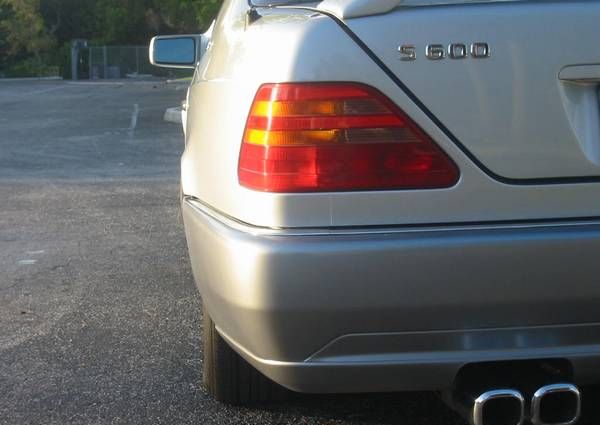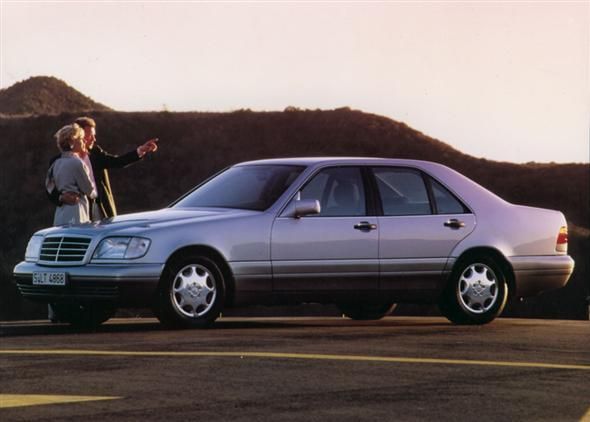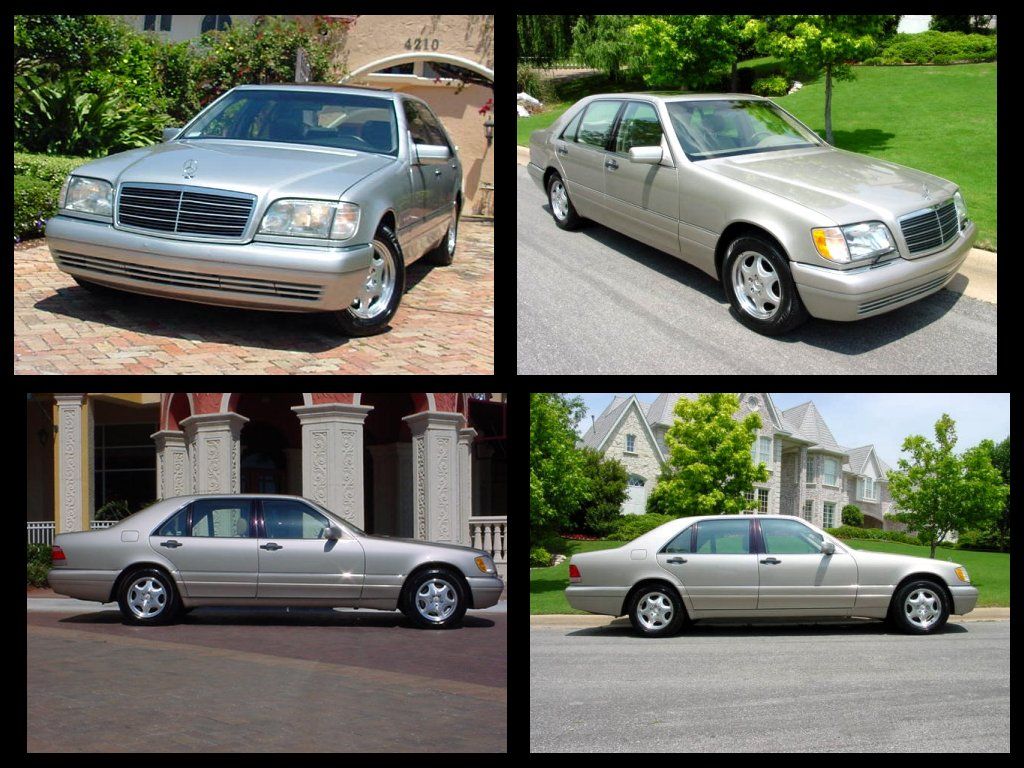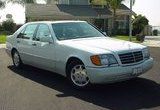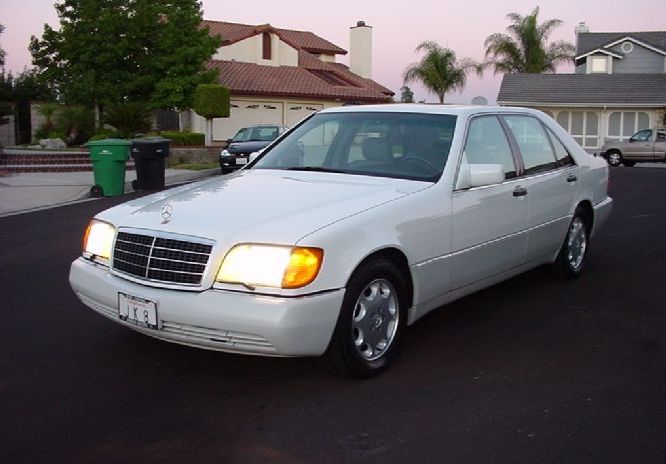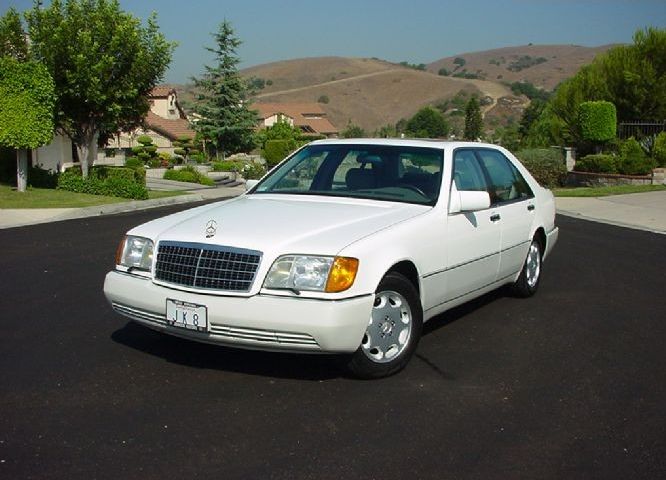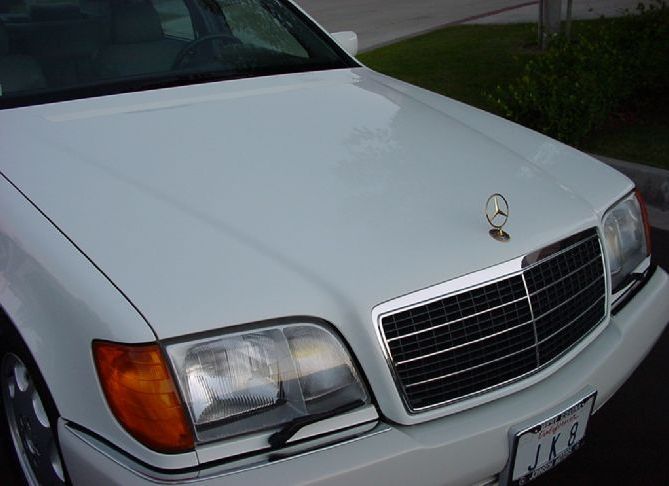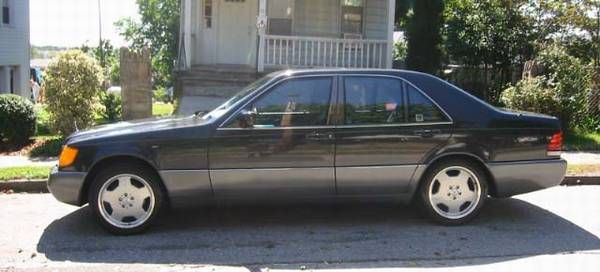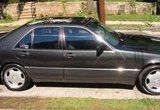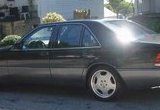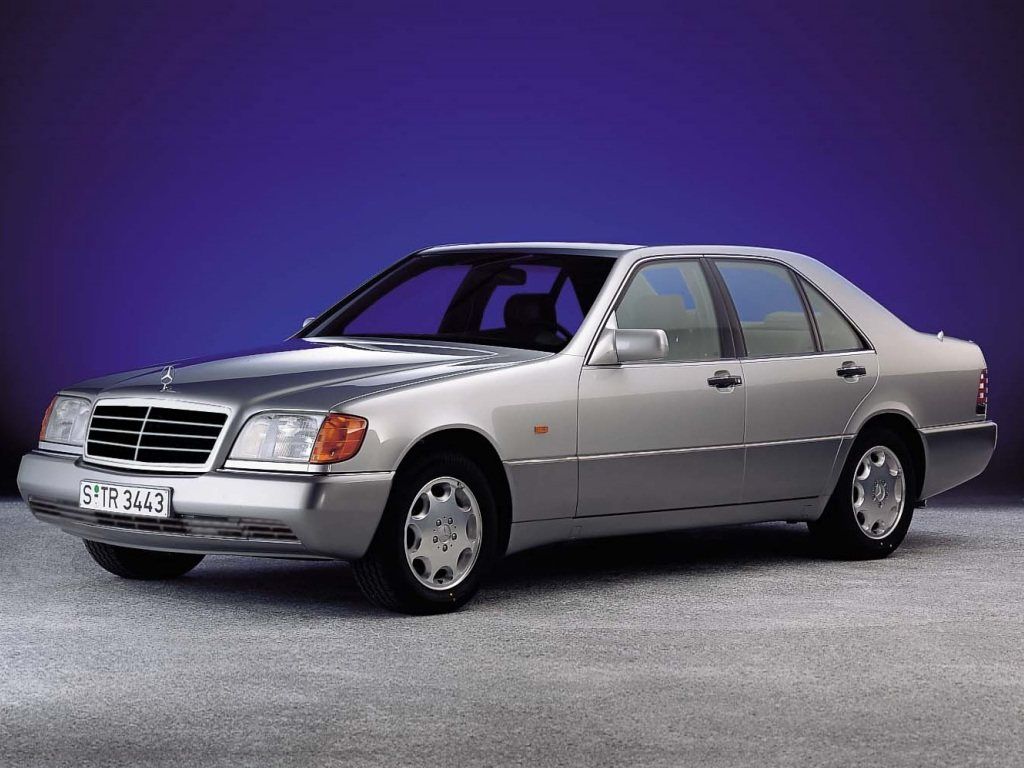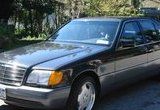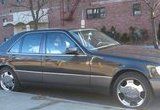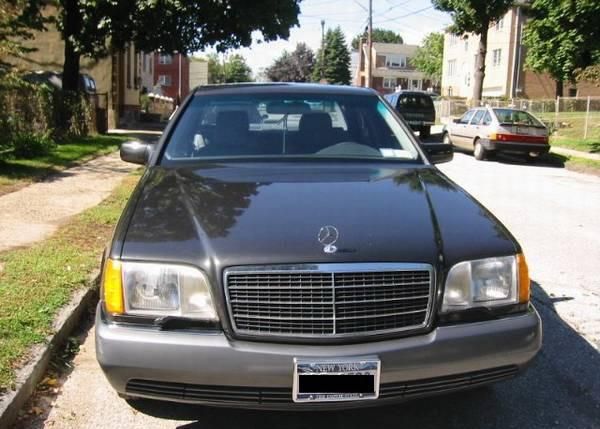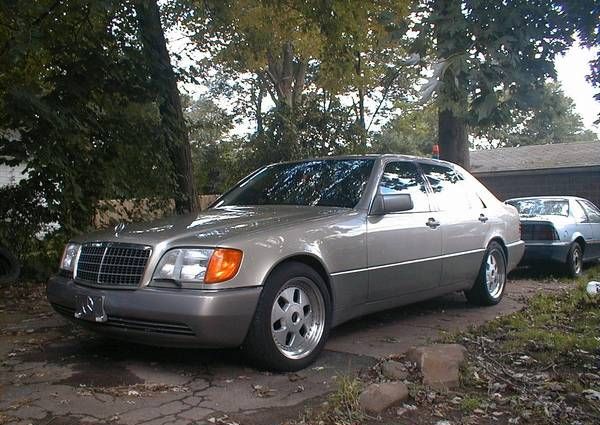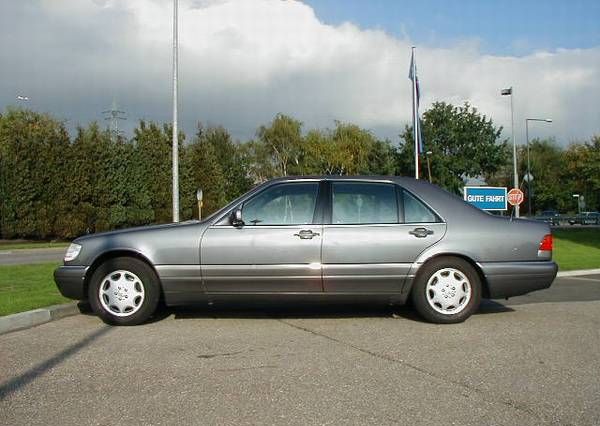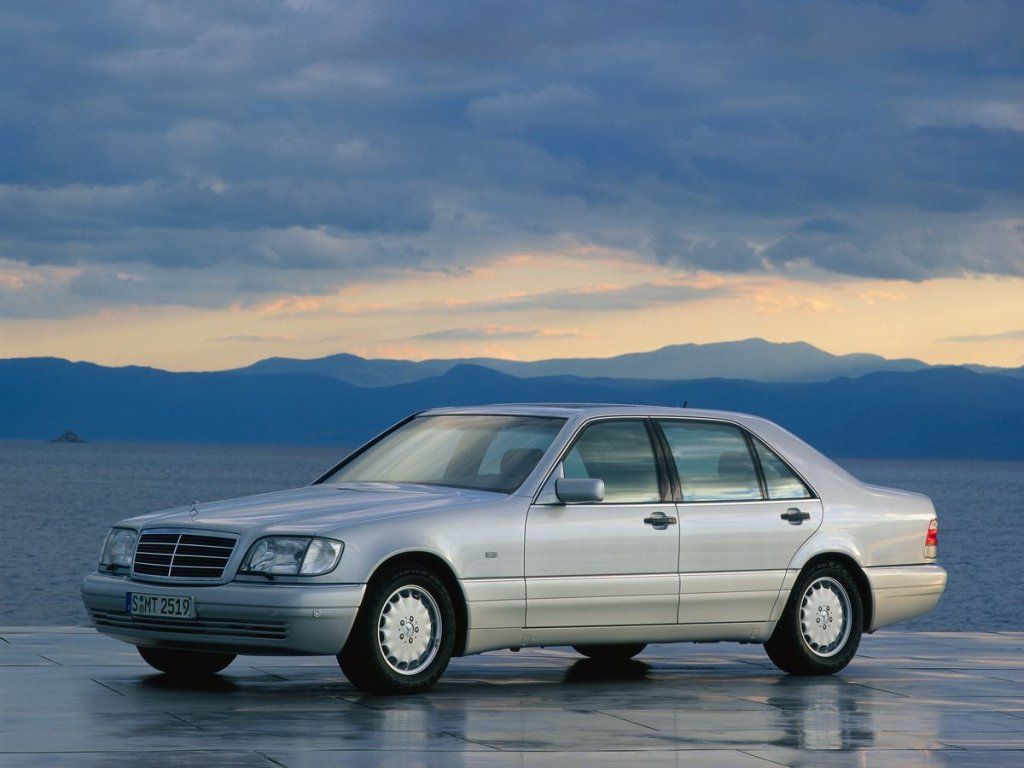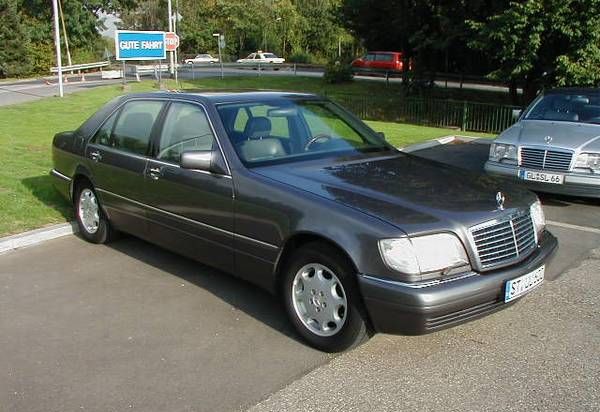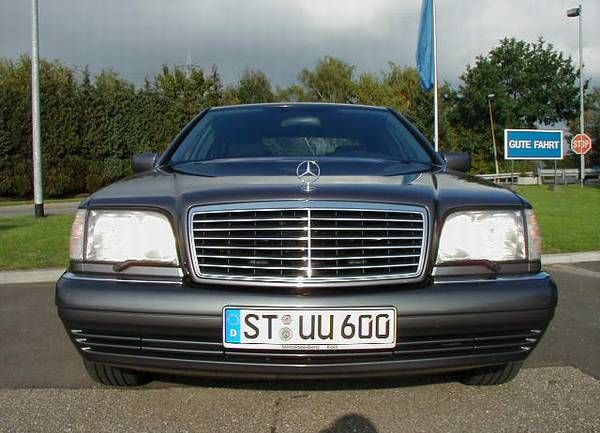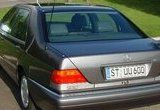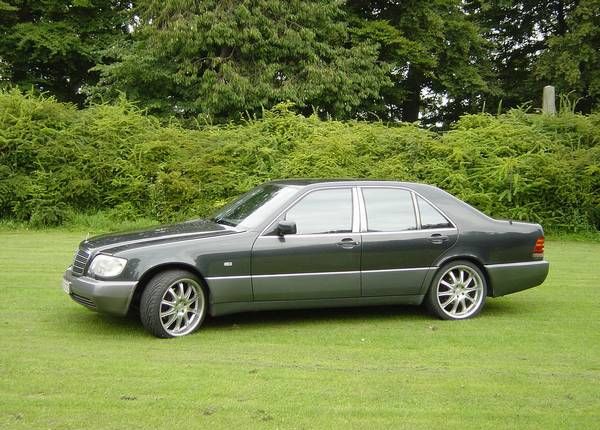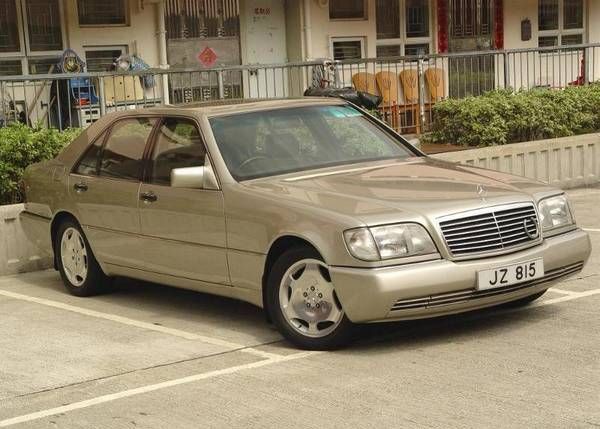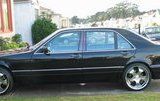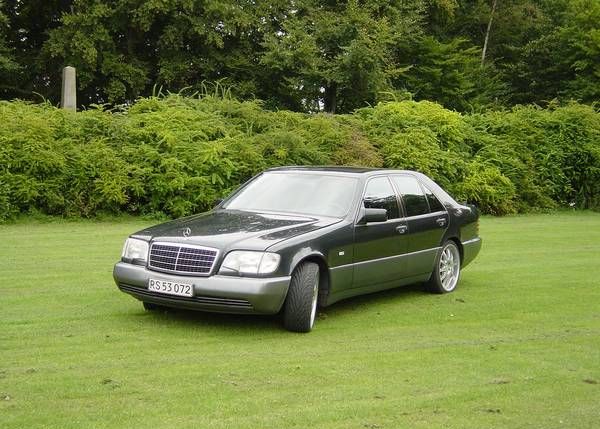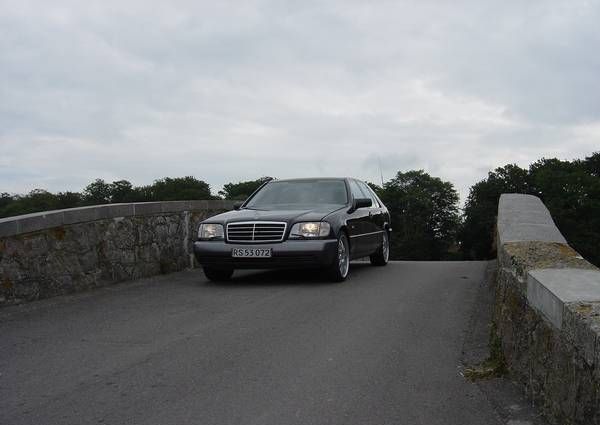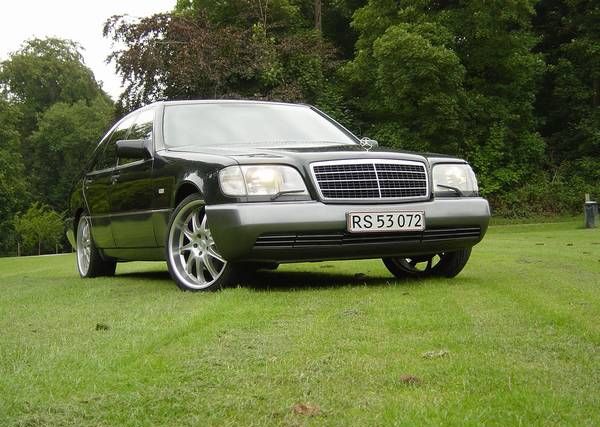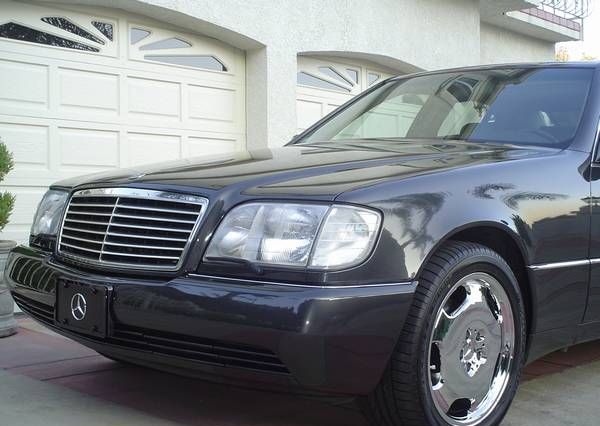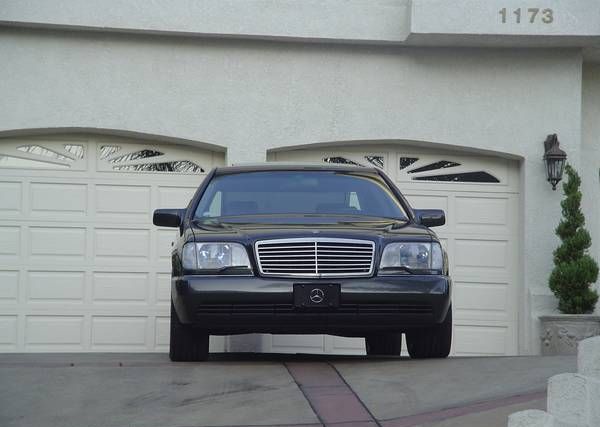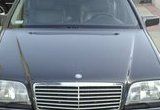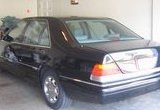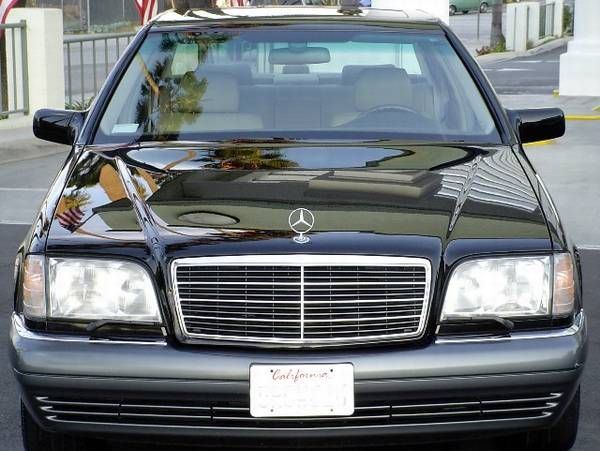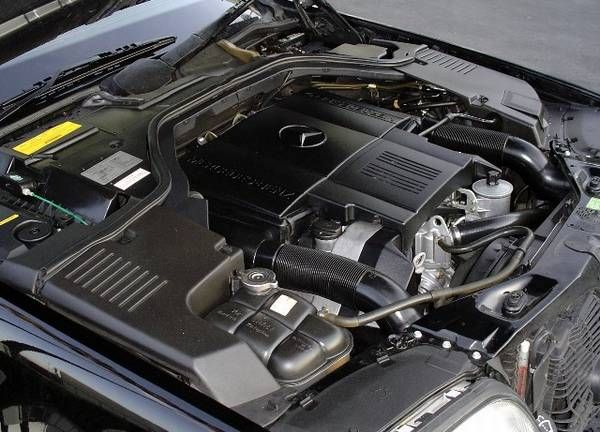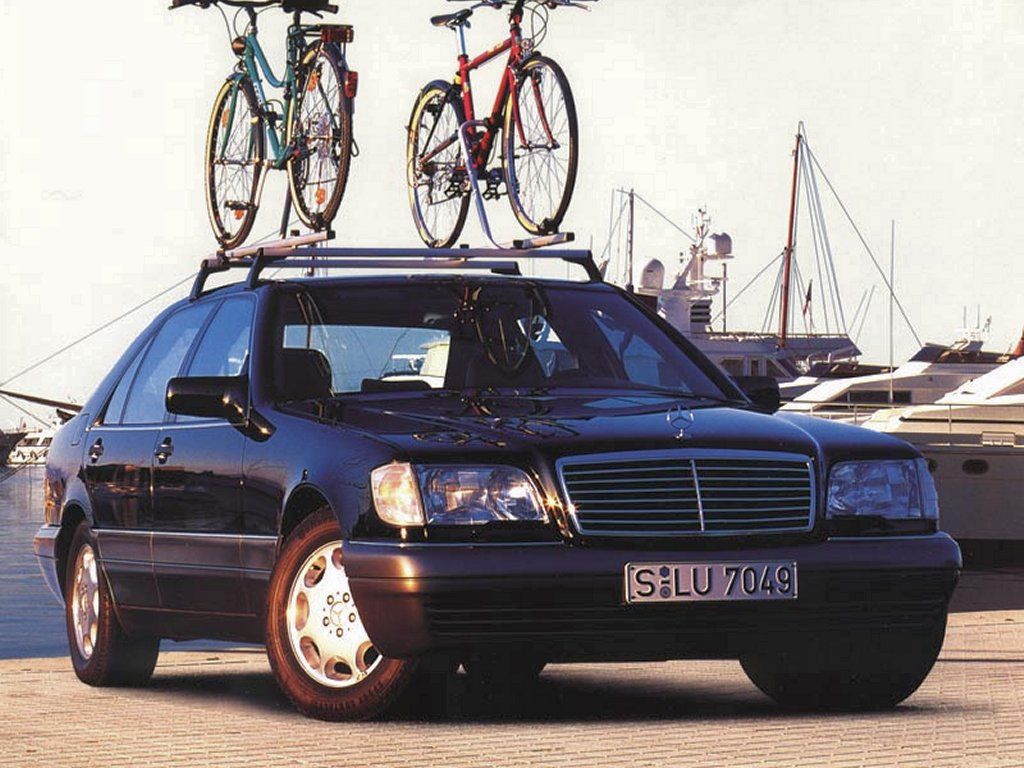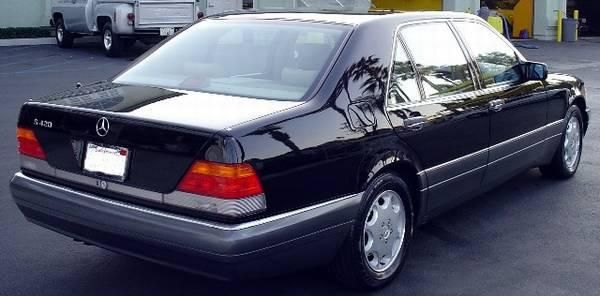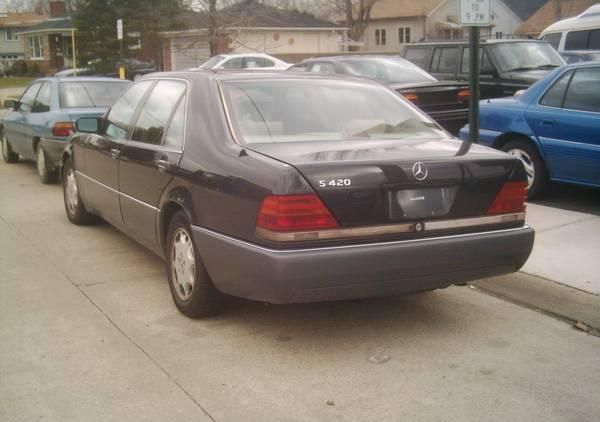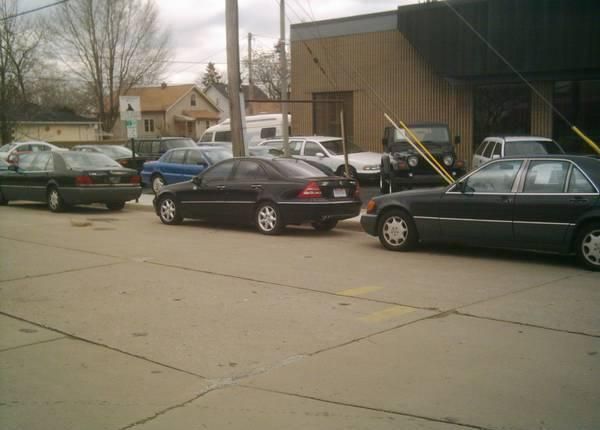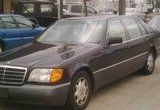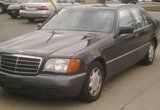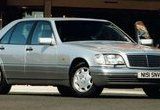At the Geneva Motor Show in March 1991 Mercedes introduced the S-Class from the W 140 series. A newly developed double wishbone front axle, mounted on a subframe, provided front suspension - a system designed to isolate the body from audible and perceptible vibrations. Ride comfort was also improved considerably by the soundproofing properties of the windows, the first time this feature had been used in a passenger car series. The 6.0-liter V12 engine was a completely new design, and not only the first series-produced twelve-cylinder ever built by Mercedes-Benz for a passenger car, but also the most powerful Mercedes-Benz car engine, with a rated power output of 300 kW (408 hp). In June 1993 the model designations were changed so as to place the “S” in front of the three-digit number. At the Geneva Motor Show in March 1994, the S-Class sedans appeared with discreet stylistic revisions. With effect from December 1996 the S 280 and S 320 models with automatic transmission were also equipped with the dynamic handling control system ESP. At the same time another innovation - and world first - was put into operation: Brake Assist. At the start of its career and particularly in Germany, the largest ever S-Class did not have an easy time of it - despite having undeniable qualities. Nevertheless, by September 1998 a total of 406,532 sedans from the W 140 series had been built - 28,101 of them with diesel engines.
1991 - 1998 Mercedes S-Class 1991 - 1998 (W140)
- Make: Array
- Model: 1991 - 1998 Mercedes S-Class 1991 - 1998 (W140)
- Horsepower: 0@0
As with the predecessor models of the W 126 series and generations of Mercedes-Benz premium-class series before them, the normal version was also accompanied by a long-wheelbase variant, in which the additional 100 millimeters served exclusively to increase legroom in the rear. As far as the engine was concerned, initially four units were available on the domestic market, of which only the 5.0-liter V8 four-valve M 119 was an old and familiar friend. As with the 500 E model from the W 124 series, the engine featured the fully electronic Bosch “LH Jetronic” injection system, controlled via a hot-wire air mass sensor. The other three engines were newly developed: Like the 5.0-liter unit, the 4.2-liter four-valve V8 was based on the 4.2-liter two-valve engine, and the six-cylinder in-line engine with 3.2-liter displacement was based on the 3.0-liter four-valve unit introduced two years earlier. An interesting detail to note here is that the model designation of the 3.2-liter and 4.2-liter models did not reflect exactly the displacement as had always been the case in the past. Instead, for the sake of homogeneity the designations 300 SE/SEL and 400 SE/SEL were chosen.
The Twelve-Cylinder
The 6.0-liter V12 M 120 engine was an entirely new design, not just the first series-produced twelve-cylinder Mercedes-Benz passenger car, but also the most powerful Mercedes-Benz car engine of its day with a rated power output of 300 kW (408 hp). With rated torque of 580 Newton meters, it reached the 500-newtonmeter mark at 1600/min. As with the six-cylinder and the two V8 engines, the twelve-cylinder was also equipped with four-valve technology, variable intake camshaft and an electronic injection system with hot-wire air mass sensor. With all engines a high priority was placed on minimizing exhaust emissions and reducing fuel consumption. The new fully electronic ignition system calculated the optimum ignition point from 300 ignition maps, tuned for each cylinder individually and to the knock limit in each case. The M 120 was the only twelve-cylinder engine worldwide to feature this cylinder-selective anti-knock control. This alone made possible the high compression ratio of 10:1, necessary for optimum use of fuel.
Engine and drive management was also completely new. Here, all control modules communicated with one another via a common data channel, which meant that the control units were jointly active. This served for rapidly warming up the catalytic converters on cold-starting the engine, for example, as well as for acceleration skid control (ASR) and for the new engine friction torque control, which maintained handling stability during power-off situations on slippery road surfaces.
The V12 offered the world's largest catalytic converter unit for passenger cars. With a seven-liter volume in order to avoid any excess fuel consumption on account of the catalytic converter, it ensured a high degree of long-term stability. Thanks to an innovative concept involving a double-walled and triple-insulated exhaust manifold, as well as double-walled pipes, the ceramic catalytic converters - embedded in insulating expandable matting - reached the optimum operating temperature in a very short time.
-----
Environmental Compatibility
In addition to optimizing and reducing exhaust emissions, the Mercedes W 140 series also featured a number of other details that made it a pioneer for environmentally compatible automotive production. It heralded the age of the CFC-free (chlorofluorocarbons) car and set new standards in terms of recycling. The plastic components used were not only recyclable and clearly identifiable, they were also to a large extent manufactured using regranulated plastics. In 1992 the W 140 series won an environmental award from the US Environmental Protection Agency, the “Stratospheric Ozone Protection Award.”
Apart from reducing fuel consumption and optimizing environmental compatibility, development of the W 140 series placed a special emphasis on raising comfort and safety to new levels of perfection. In this respect, the meticulous design and coordination of the running gear played a particular role. A newly developed double wishbone front axle, with the main point of load application mounted on a subframe, provided front suspension - a system designed to isolate the body from audible and perceptible vibrations. Rear suspension was derived from the multi-link independent suspension of the other passenger car series, although radically revised in terms of wheel location and modified in line with the special requirements of the Mercedes S-Class. To take account of the significantly greater longitudinal and transverse forces, the link geometry was also redesigned. Of particular interest was the crossed design of the upper links, which allowed axle space to be kept to a minimum in spite of the long control arms.
In terms of active safety the S-Class sedans in the W 140 series were known for their exceptionally good straight-line stability even on uneven road surfaces, their low crosswind sensitivity, precise and responsive steering and handling which remained relatively unaffected by the size of payload. The brake system for the eight and twelve-cylinder models was a fundamental innovation. By distributing more braking power to the rear wheels, it was possible to improve the fade resistance of the brake system and reduce wear to the front wheel brakes.
High Degree of Ride Comfort
Ride comfort in the W 140 series was improved significantly once again. Any tire noise and vibrations transmitted to the passenger cell were largely reduced, the pitching motion on moving off and braking was minimized, rolling motion on cornering or uneven road surfaces was reduced and the steering was made virtually insensitive to jolts transmitted from the road. A so-called “parameter steering” with speed-sensitive steering moment was fitted as standard to the eight and twelve-cylinder variants, reducing the steering effort required by the driver at low speeds, for example when parking.
Safety had already been taken to high standards in the predecessor model series, but here numerous measures achieved further improvements. The new body structure, for example, provided even more safety in all types of accidents. And a series of small design appointments designed to reduce hazards from potential impact points also gave added protection to other road users.
The first soundproofed glass windows to be fitted to a passenger car series also made a significant contribution to improving comfort and incorporated a range of safety and comfort features. They avoided the tendency to fog or ice up and reduced condensation, gave better heat insulation as well as soundproofing from external noise, improved external air flow and eliminated wind noise caused by window seals.
Two further design details - folding exterior mirrors and extendable guide rods to help with reversing - gave drivers additional assistance when maneuvering in small spaces with poor visibility. The electrically-operated exterior mirrors could be folded back to gain extra space when maneuvering in tight situations by means of a centrally-positioned switch on the center console, the same switch serving also to angle the mirrors correctly. In order to assist with judging distances to obstacles when performing reversing maneuvers, two extendable guide rods were integrated into the rear fenders to left and right. Two seconds after selecting reverse gear, the pneumatically operated 65-millimeter-long chrome rods automatically extended vertically, returning again eight seconds after a new gear had been selected.
-----
Discreet Revisions
At the Geneva Motor Show of March 1994 the S-Class sedans were presented with discreet stylistic modifications. A series of modified details gave the optical illusion of a lighter, better proportioned and more dynamic appearance - even though external dimensions remained unchanged. This was achieved by a distinctive “tucking-in” of the lower parts of the bumpers and side skirts and by the horizontal subdivision of these surfaces by means of a beading running all the way round. The effect was reinforced by modifying the design of the headlamps and radiator protection grille. In the modified headlamps with optimized variable-focus reflectors, which increased light output by 60 percent, the dipped-beam compartment was no longer separated by a central bar from the high-beam compartment, thus lending the illusion of greater breadth. This impression was underlined by the addition of colorless glass covers for the front turn indicator lamps. The six-cylinder and eight-cylinder models were also given a newly designed, more slender radiator grille with a vertical articulation at the center. For the V12 models there was also a special version with chrome-plated transverse fins and appreciably broader chrome frame. Formal modifications to the rear end were also a significant factor in the harmonious overall image of the S-Class. For example, the lower radii of the trunk lid joints were rounded off in the same style as the coupe models. The taillight band was made broader beneath the rear lamps and shaped to fit the new bi-chromatic design of the rear lights. This served to flatten off the height of the trunk and to make the rear end as a whole appear broader and lower set.
From May 1995 the ultrasonic reversing aid “Parktronic” was available as an option. Ultrasonic signals emitted by the system were reflected by any obstacle encountered and the distance between vehicle and obstacle was then calculated by an electronic control unit. Transmitters and receivers of the ultrasonic signals were combined in sensors integrated into front and rear bumpers, without diminishing in any way the protective function of the bumpers. Parktronic was fitted as standard equipment to the V12 models from 1995 onwards. At the same time, the now superfluous guide rods in the rear fenders were discontinued in all S-Class limousines.
Improved Engines
Since the model refinement measures introduced in 1994 essentially affected design, the eight-cylinder and twelve-cylinder models saw a number of technical improvements in September 1995. A completely new five-speed automatic transmission with torque converter lock-up clutch - a unit that had been fitted to the S 600 coupe since May 1995 - now replaced the four-speed transmission with hydraulic control in the sedans. At the heart of this technological miracle was an electronic transmission control unit which adapted gear-shifting rapidly and automatically to any given driving situation and which continuously exchanged data with the electronic engine management system. In addition to these pioneering innovations, the new automatic transmission was also much more compact and lighter than were comparable five-speed transmissions. To further improve fuel consumption and reduce harmful emissions the engines underwent more revisions. The two V8 engines were given a modified crankshaft, an optimized valve control system, lighter pistons, dedicated ignition coils for each cylinder and an improved electronic engine management system of the Motronic ME 1.0 type which integrated a hot-film air flow sensor in the place of the hot-wire air mass sensor. Modifications to the V12 engine were less extensive and affected only the arrangement of the ignition coils and the electronic engine management system. Thanks to the various modifications to the engine and the introduction of the new automatic transmission, fuel consumption for the V8 and V12 models could be cut by seven percent on average without any loss in output, and exhaust emissions by over 40 percent. September 1995 also saw the introduction of the Electronic Stability Program (ESP) as an option for all S-Class models with eight-cylinder engines, a system that helped the driver to correct driving errors by automatically counteracting momentary instability by sensor-controlled brake intervention, thus contributing to active safety. ESP was introduced as standard equipment in both twelve-cylinder models.
In addition to the model refinement package outlined above and presented at the IAA in Frankfurt, in September 1995 a new S-Class variant was premiered: The S 600 long-wheelbase Pullman. Developed as a new official representational sedan and equipped with special protection technology, this vehicle continued a long Mercedes-Benz tradition. The special-production car measured 6,213 millimeters in length and was therefore exactly one meter longer than the long-wheelbase S 600. The extra length served to benefit the rear passengers, comfortably accommodated on seats arranged in vis-à-vis format and separated if required from the driver's compartment by a glass partition. The Pullman sedan in the W 140 series was also available as both S 500 and S 600 without armoring. The first units of both variants were produced in August 1996.
In line with tradition, the normal five-seater sedans in the S-Class were also available as armored versions - with a choice of 5.0-liter V8 or 6.0-liter V12 engine. Production of both these armored models began in February 1992, one year after main production start-up for the W 140 series.
-----
Further Improvements
In June 1996 the S-Class underwent further improvements. Now the five-speed automatic transmission with torque converter lock-up clutch and electronic engine management was also available for the six-cylinder models - as an option on the Mercedes S 280, and as standard on all other models. At the same time the ASR acceleration skid control system also became part of the basic equipment on the six-cylinder models. Other innovations to note included sidebags as standard for driver and front passenger on all models, seat occupancy sensors to operate the front passenger airbags, an “intelligent” rain sensor that controlled the wiper interval in accordance with the volume of spray on the front windshield, and luggage nets in the trunk and front passenger footwell. Xenon headlamps with headlamp wash/wipe system and dynamic headlamp range adjustment were available as optional equipment. Externally, too, the S-Class sedans had undergone slight modifications when they were presented in June 1996; immediately apparent were the satin-finish detachable body components, now painted in the color of the car rather than as previously in the contrast color.
Apart from these detail improvements described above, in June 1996 a model change in the S-Class came into effect: The S 350 Turbodiesel was replaced by the S 300 Turbodiesel. In contrast to its predecessor, the new diesel model offered a turbo engine with four-valve technology and intercooling. Engine output was 27 hp higher, at 177 hp; torque was increased by 20 Newton meters and available over a broad range of engine speeds; exhaust emissions and fuel consumption were much lower as a result of optimized combustion. The S 300 Turbodiesel came as standard with the electronically controlled five-speed automatictransmission.
From December 1996 the S 280 and S 320 models with automatic transmission were also equipped with the ESP dynamic handling control system. At the same time a new innovation had its world premiere as an additional active safety feature - Brake Assist, which was fitted as standard in all R 129 and W 140 models from December 1996. Brake Assist (BAS) was able to recognize emergency braking situations and if required to boost brake power to a maximum more quickly than was previously the case, thus shortening stopping distances considerably.


